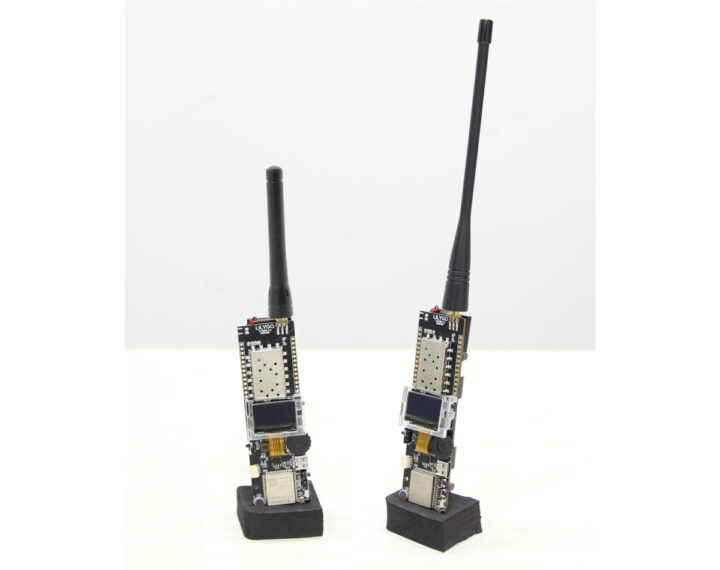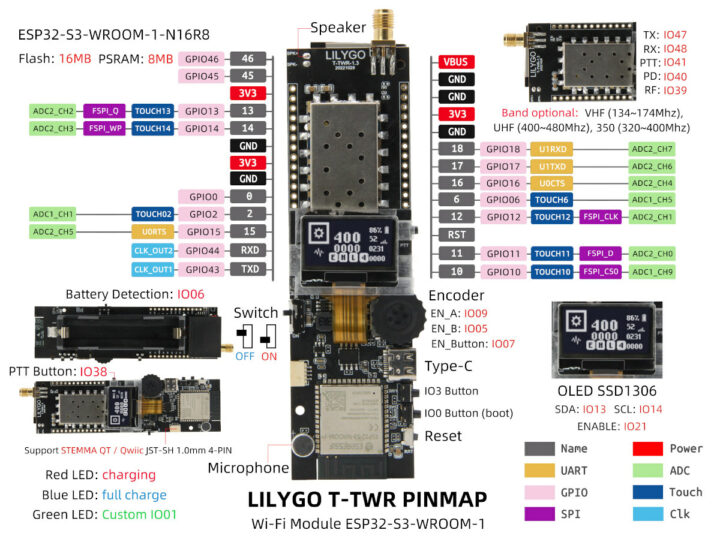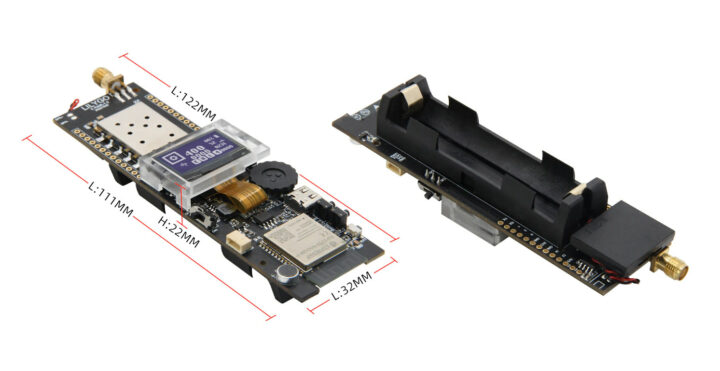LILYGO T-TWR is an ESP32-S3 development board fitted with an SA868 Walkie-Talkie module and a UHF or VHF antenna, a speaker, a microphone, a small 0.96-inch OLED, and a 18650 battery holder, plus some I/Os for expansion.
Equipped with an ESP32-S3-WROOM-1-16NR8 module, the T-TWR offers WiFi 4 and Bluetooth 5.0 connectivity, a dual-core processor with 16MB flash and 8MB PSRAM, and enables users to design their own Walkie-Talkie, while its expansion capabilities allow the control of devices.

LILYGO T-TWR specifications:
- Wireless module – Espressif ESP32-S3-WROOM-1-N16R8 module with ESP32-S3 dual-core LX7 microprocessor @ up to 240 MHz with Vector extension for machine learning, 16MB FLASH, 8MB PSRAM, WiFi 4 and Bluetooth 5 LE/Mesh
- Display – 0.96-inch OLED with 128×64 resolution based on SSD1306 I2C display driver
- SA868 Walkie-Talkie module based on RDA1846S chip
- Bandwidth: 12.5 kHz/25 kHz
- Sensitivity: -124 dBm
- Support 1.6W or 1.8W mode. The latter is not recommended due to the high temperature when enabled
- Three types:
- UHF @ 400-480 MHz
- VHF @ 134-174 MHz
- “350” @ 320-400 MHz
- SMA antenna connector for UHF/350 antenna or VHF antenna
- Audio – Speaker and microphone
- USB – 1x USB Type-C port for power/charging and programming
- Expansion
- 2x 13-pin headers with up to 16x GPIO, 10x ADC, 2x UART, 1x SPI, Touch interface, 5V (VBUS), 3.3V, and GND
- 4-pin STEMMA QT/Qwiic connector
- Misc
- Boot, Reset, and user (IO3) button
- Battery switch
- Three-way encoder & switch
- Power Supply
- 5V via USB port
- 18650 battery holder and TP4054 charging chip
- Dimensions – 122 x 32 x 22 mm (with SMA connector)
The T-TWR ESP32-S3 Walkie-Talkie board can be programmed with the Arduino IDE or PlatformIO, and LILYGO provides documentation as well as schematics (PDF), datasheets, and sample code on GitHub. Two samples are provided one using the board as an actual Walkie-Taklie, and the “at_debug” demo to control the board through AT commands over a serial interface.
LILYGO is selling the T-TWR board for $41.98 to $45.98 on Aliexpress including shipping, but not taxes (VAT). It provides an alternative to the SOCORAD32 ESP32 walkie-talkie board that is currently offered on Crowd Supply for $80.

Jean-Luc started CNX Software in 2010 as a part-time endeavor, before quitting his job as a software engineering manager, and starting to write daily news, and reviews full time later in 2011.
Support CNX Software! Donate via cryptocurrencies, become a Patron on Patreon, or purchase goods on Amazon or Aliexpress






